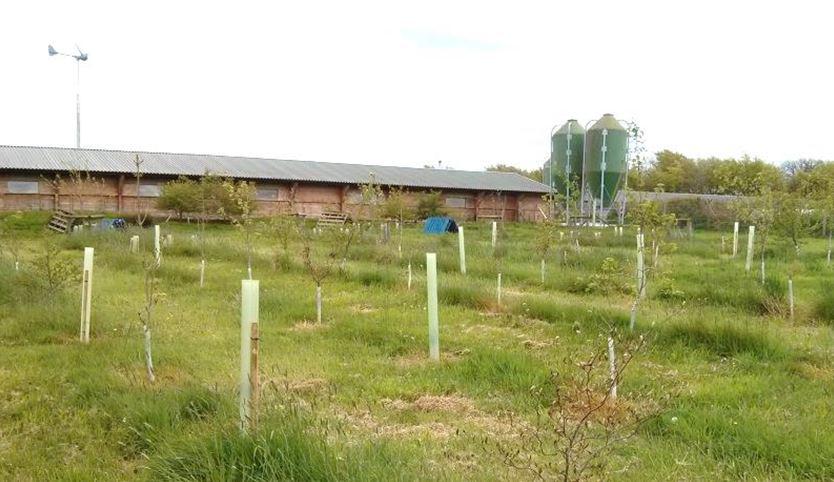
Agroforestry for poultry systems, UK
Description of system
Agroforestry poultry systems in the UK can be divided into egg-production and poultry-meat production systems. Some of the eggs produced by hens with access to areas of trees are marketed as “woodland eggs”. At a minimum, all “woodland eggs” follow the standards for free-range egg production.
Eggs: annually around 11.5 billion eggs are consumed in the UK with a retail value of about £990 million. In 2013, free-range eggs accounted for 44% of the UK market. European Commission Regulation 589/2008 Annex II specifies minimum conditions for “free-range” egg production such as providing the hens with access to open space and a maximum density of 2500 hens per hectare. To qualify as ‘woodland eggs’, the UK Woodland Trust, which adds its logo to the woodland eggs sold by Sainsbury’s plc (a major UK retailer), specifies 20% cover in the free range area with some trees within a 20 m distance from the shed. In 2013, the Woodland Trust reported the sale of about 400 million “woodland eggs” through Sainsbury’s, equivalent to about 3.4% of the UK market (Burgess et al., 2014). Other retailers also sell woodland eggs
Poultry meat: the output of meat from poultry in the UK (£2.3 billion in 2013) is second only to cattle. The proportion of chickens and other poultry with access to trees is not known.
If you would like to know about the activity of this group, please contact Dr. Jo Smith at the Organic Research Centre.
Initial stakeholder meeting
A first stakeholder meeting focused on the use of trees in poultry-meat production was held on 6 May 2014 with 28 attendees. Two potential innovations that could be further investigated in on-farm trials are: i) the development of shade-tolerant sward mixtures that can persist under the trees, and ii) the design and management of the trees to encourage birds to range further away from the houses.
On 10 June 2014, another initial meeting focused on the use of trees in egg production systems, which was attended by 10 stakeholders. The selection and establishment of suitable swards and grass-herb-mixes, and particularly techniques for reseeding bare areas, were mentioned as possible research needs.
Download the initial stakeholder report
References
Burgess, PJ, Belot, V, Buachie E, Cuartero de Frias F, Nedved K, Rodríguez Arquero, E (2014). The Economics of Woodland Eggs in the UK. 2nd European Agroforestry Conference 04-06 June 2014 Cottbus – Germany, Book of Abstracts 67-70. (Eds JHN Palma, A Chalmin, P Burgess, J Smith, M Strachan, J Ruiz Mirazo, A Rosati), ISBN: 978-972-97874-4-7.
Download the initial research and development protocol
A research and development protocol was produced in June 2015.
Download the system description
A progress report on the research including a system description was produced in March 2016.
Lessons learnt
In a report produced during 2017, Sally Westaway with colleagues describes the results of the experimental work. The research focused on performance of three pasture mixtures sown under trees in a silvopoultry system. Establishing a sward under the trees is possible but the challenge is to maintain the sward in the presence of chickens. The three tested seed mixtures (a standard sward, a grass-only sward, and a diverse sward) showed a similar coverage of sown plants in the first six weeks after seeding. One of the recommendations from the research is that sufficient time is provided to allow the reseeded pasture to establish before the re-introduction of the hens. Following the re-introduction of the hens, the sown sward mixtures only survived only in the block with lower chicken pressure, measured by distance from the hen house. Hence designs that prevent excessive pressure from the flock appear to be necessary to help maintain the pasture sward.